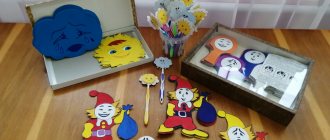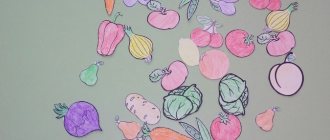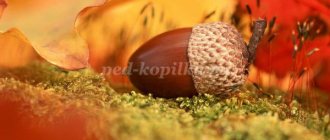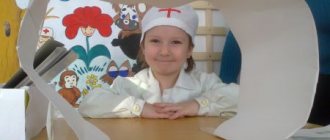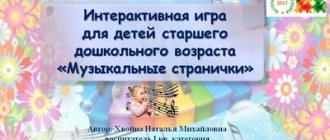Summary of the musical-didactic game in the senior group “What do I play?”
Irina Sosidka
Summary of the musical-didactic game in the senior group “What do I play?”
Purpose of the game: Development of timbre hearing.
Software tasks:
1. Improve the skill of playing musical instruments (keyboards, percussion and strings: piano, violin, cello, balalaika).
2. Develop children's creativity, encourage them to take active independent action.
3. To foster emotional responsiveness to music in children.
Game material: Cards (according to the number of players)
, on one half of which there is an image of children's musical instruments, the other half is empty; chips and children's musical instruments.
Progress of the game:
Children enter the hall to the music.
Teacher: Hello, guys! I found this cute box in the music room today. But I didn’t open it without you. What do you think might be in it? (Children's answers).
Teacher: Well, guess what, let’s open it together and take a look!
(Open them - there are cards, on one half of which musical instruments are depicted, and the other half is empty and chips).
Teacher : Guys, why do we need this?
Children: For playing.
Teacher: Of course, for the game. And you and I will play the game “What do I play on?” This is a game for developing timbre hearing.
The teacher distributes several cards to the children.
Teacher: For this game we will need a leader. Who wants to be the presenter? (All children raise their hand)
. Let's do it in such a way as not to quarrel, using a counting rhyme we will choose a leader:
“One day a mouse came out to see what time it was.
One, two, three, four, the mouse pulled the weights.
Suddenly there was a loud ringing sound, get out of the circle!”
Teacher: Nikita is our leader, for this game he will have to play a melody or rhythmic pattern on any instrument at his discretion behind this screen (there is a small screen in front of the leader)
. And you guys must determine the sound of this instrument and cover the second half of the card with a chip. It's clear? Then we start playing.
(They play several times, the child leader changes with the help of a counting rhyme, or the child who closed his cards faster than the others becomes the leader).
Teacher: Our game is over, let's put all the attributes back in the box. Guys, did you like the game? What exactly did you like about it? Was it easy for you to recognize the sound of musical instruments? Who found it difficult? Who was unhappy? Who wants to play this game again next time? You guys tried really hard, well done!
Summary of a play-based integrated music lesson in kindergarten. Preparatory group
Integrated music and game lesson “A TALE ABOUT THE HARRES” (musical and speech development).
Author : Valitova Larisa Vladimirovna Description: the lesson notes can be used for an open demonstration on the gaming, musical, speech therapy development of children. Goal: creating conditions for the development of speech through music. Objectives : 1. To form a rhythmic and musical ear.
2. Develop sound pronunciation. Progress of the lesson.
Children enter the hall and stop in a semicircle.
Musical director: - I see your eyes sparkle. So, let's listen to a fairy tale. Bunnies and a hare lived peacefully and quietly in the little house. The bunnies walked every day and breathed fresh air. 1. The speech exercise “Hares” is carried out. (M.Yu. Kartushina. Notes of logorhythmic classes)
- The bunnies stood up under the birch tree and danced near the birch tree..... 2. Dance - game “Zainka” (Russian folk song). Musical director: - And then they played some more, everyone knocked with their spoons... (children rhythmically knock with spoons, pronouncing the words of the nursery rhyme). 3. Didactic game “Bunny, Bunny...” . Bunny, bunny, bunny is sitting under a bush. Bunny, bunny, bunny is trembling under the bush. Bunny, bunny, bunny got wet under the bush. Bunny, bunny, bunny couldn’t hide.
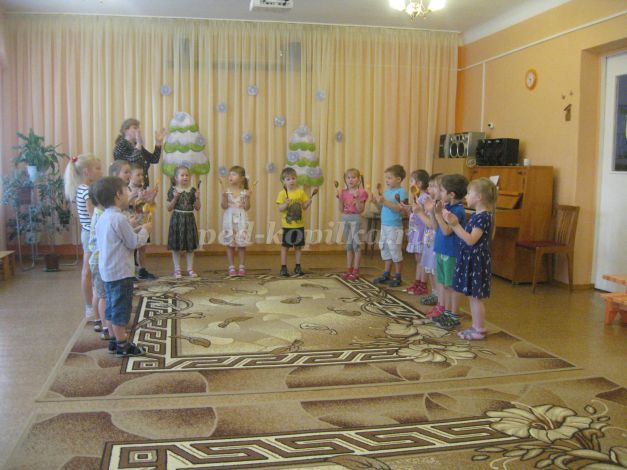
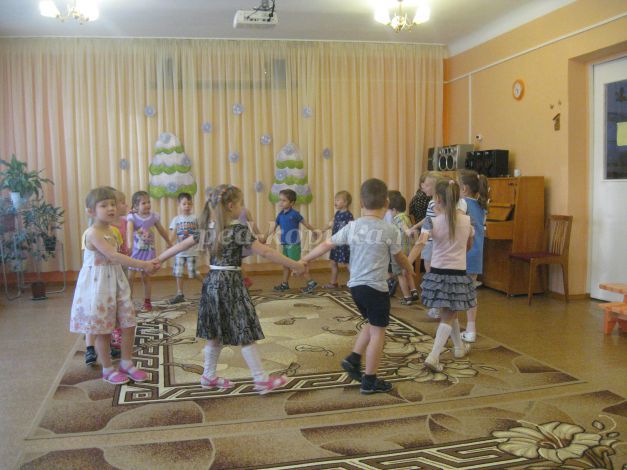
2 times And under the slide - snow, snow,
lower their hands down
And on the Christmas tree - snow, snow
at the top they join their palms in a “house”
And under the tree there is snow, snow
they lower their hands
And under the tree a bear sleeps
, palms under the cheek, close your eyes
Quiet, quiet.
Keep quiet! they shake their finger
- The bunnies are hiding... And who is that walking through the forest?... Fox.... (put the Fox’s hat on the child)
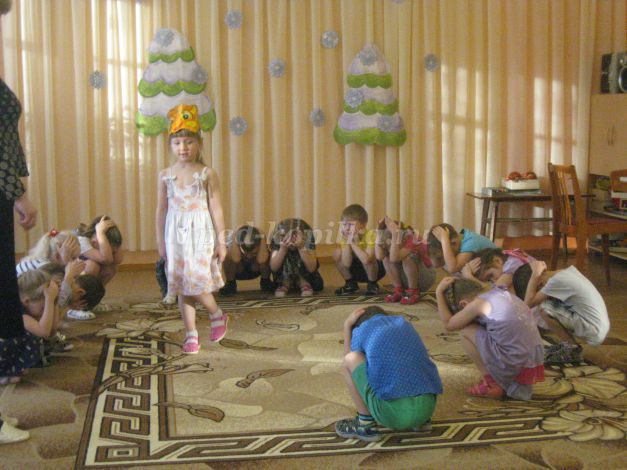
6. Game - dramatization Children walk in a circle: Fox - sister, fluffy fur coat Where have you been? Who did you see? Chanterelle: I’ve been to the village and seen a cockerel. He sits on the fence, shouting songs to the sun: “Ku-ka-re-ku!” (imitation of movements) Children: ……….Where else have you been? Who else did you see? Chanterelle: I was in the field, I saw a mouse there. The mouse gnaws grains, also sings a song: “Pi-pi-pi!” (show). Children: ……… Where did you go later? Who did you see later? Chanterelle: She ran along the bridge and saw a frog. He sits near the river, shouts loudly and loudly: “Kwa-a-a!” (jump). Children: …….. Where did you run? Who did you see? Chanterelle: She ran into the dense forest and saw white hares. The hares shouted: “Trouble!” Run away in all directions!” (clap their hands, run away from the fox) - No! Come back, bunnies! Better play with the fox! 7. Didactic game “Jump, Jump, Jump.” Why are you, little bunny, sitting, why are you, little bunny, silent? One - jump, two - jump. Jump, jump, jump. (Children are located in a circle, in the center there is one “hare” child. Children pronounce the words, “threatening” their finger. On the second line, the child rhythmically jumps on two legs, performing five jumps towards one of his comrades. The one before whomever he jumps becomes the next “bunny”).
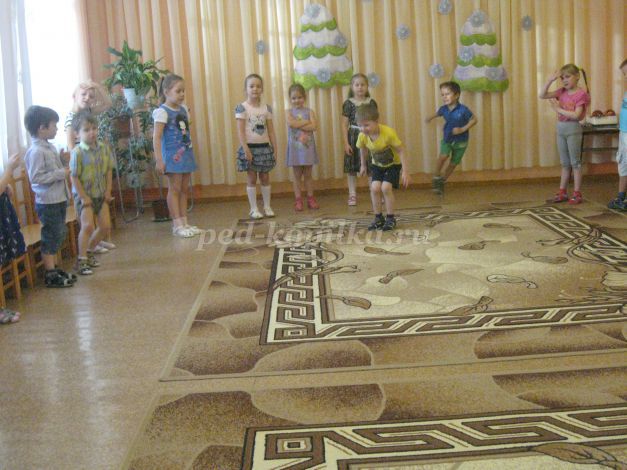
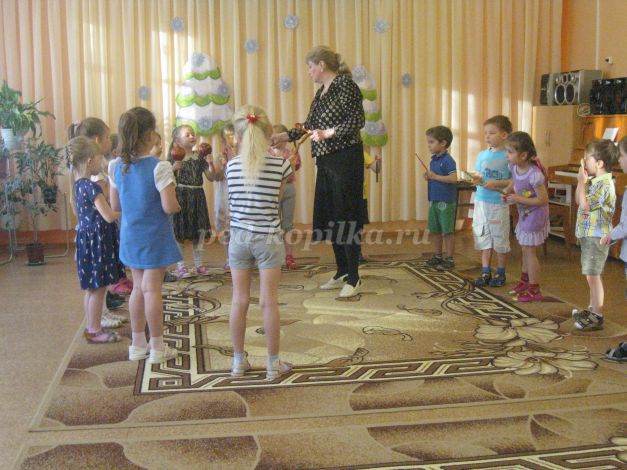
And the hedgehogs found a bag.
exhalation.
A wolf and a fox came running.
“chap-chap”, “top-top” in the middle register
The bunny is small, oblique,
“jump-hop” abruptly in the upper register
Bullfinches flew in.
they pull “svir-r-ry...” in the upper
partridges, wood grouse.
pull “fr – r – r...” with a long exhalation.
- Let's see what's in the bag?...... Snowman!
Let's play with him! 11. Game “Egorka the Snowman” (M. Yu. Kartushina. Notes on logorhythmic lessons).
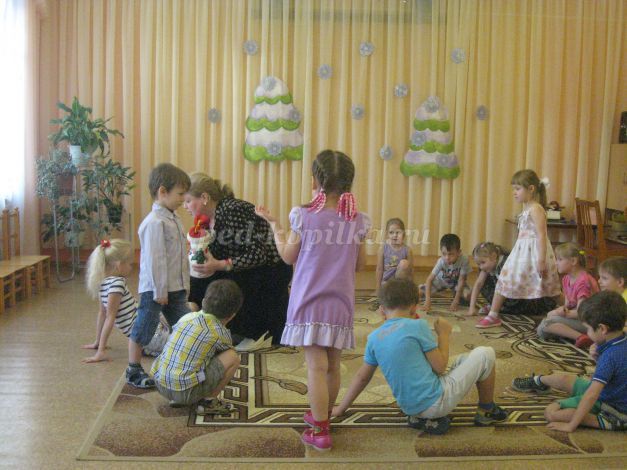
- Well done, children! Okay, you've done everything. And Santa Claus sent us a surprise! (takes out sweets and treats).
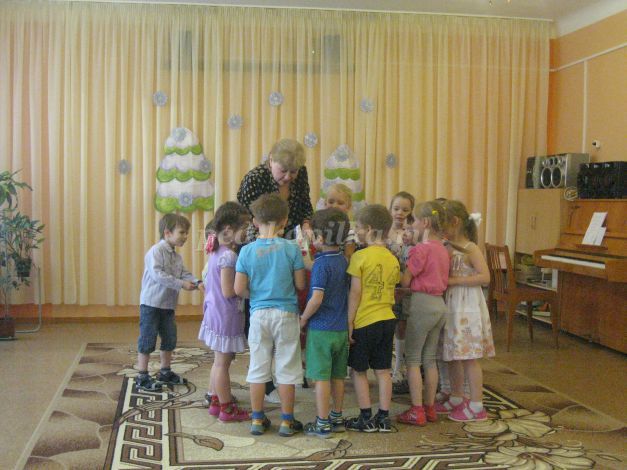
We recommend watching:
Summary of a music lesson in a preparatory group Musical and creative game for older preschoolers “Silver Snowflake” Summary of an integrated lesson in a preparatory group of a kindergarten Summary of educational activities for the perception of music in a preschool group preparatory to school
Similar articles:
Summary of a music lesson in a preparatory group on the topic: Autumn
Summary of a thematic music lesson for children 6-7 years old
Scenario of a musical literary composition based on a fairy tale by J. Rodari for children of the preparatory group
Scenario for a musical evening of entertainment in kindergarten for older children
Summary of musical and outdoor games with singing for preschool children
1. We are funny guys
We invite everyone to play in the snow,
Start making lumps
One two three four five.
(to lose, “make lumps and throw them at each other” while standing still)
2. We love skating,
Try to catch up with us
We will rush like the wind.
One two three four five.
(to lose, “skate”, moving in a circle one after another)
3. They took the clubs in their hands together,
We'll play hockey
We score a goal into the goal,
One two three four five.
(to lose, “throw a puck or ball into the goal” while standing still)
4. We sculpt a snow woman,
We need to roll a big ball,
Medium lump and a little smaller.
One two three four five.
(to lose, “roll a snowball”, moving in a circle one after another)
5. Get on your skis,
You need to take sticks in your hands,
We glide along the ski track together,
One two three four five.
(to lose they “ski”, moving in a circle one after another)
6. Let's make each other happy
We'll ride on a sled,
Our sleds are moving fast,
One two three four five.
(to lose they become pairs - one in front, the other behind, take
holding hands, running after each other on tiptoes, pretending to sled)
Notes:
1. Practice has shown that it is advisable to replace the words of the third line of each verse with the words: “We begin, we begin.” This makes the lyrics much easier to learn by heart.
2. If the children do not know the lyrics of the song well enough, at the matinee the first and second lines of each verse can be sung by some character (an adult, and the children can sing along and finish the third and fourth lines: “We begin, we begin, one, two, three, four , five"
5. “Cod and nets” (an outdoor game with singing for children 6-7 years old)
The plot of the game by Zamyatina N. N. (Collection of author’s notes on outdoor games for teachers of preschool institutions in the Northern District of Arkhangelsk “Outdoor Games with a Regional Component” Arkhangelsk 2011,
text and music by E. B. Kuznetsova
Goal: organizing children's motor activity through the use of games with a regional component.
Tasks:
- develop children’s cognitive interest in their native land
- strengthen children’s ability to act in accordance with the rules of the game;
- develop attention and imagination;
- to develop the ability of children to run in different directions in a limited area, without bumping into each other, to run away only when the musical sentence ends;
- cultivate self-control, honesty, discipline, justice.
Progress of the game:
Before the game starts, children form 2 circles, one in one. Those in the inner circle join hands - during the game they depict nets. The players in the outer circle do not hold hands; they are fish. To the music, the nets move in a round dance step to the right, and the fish one after another to the left (toe step, arms slightly pulled back, palms moving, imitating the movements of the fins). Everyone sings:
“As fishermen went out to sea to fish for cod,
They set up the nets and sing a song.”
Then everyone stops. The players in the inner circle raise their joined hands up and sing: “Catch you, cod, get caught, get caught in our nets!”
A wonderful catch awaits the fishermen today!”
At this time, the players of the outer circle - the cod - can freely run in and out of the nets. The net cannot catch the fish.
At the last word of the song, the net is lowered, that is, all the players in the inner circle lower their joined hands down and squat. The caught “fish” becomes part of the inner circle, which increases in size, after which the game resumes, or the “fish” players and the “net” players change roles.
Musical and didactic game in the senior group “Conversation in the village courtyard”
Goals:
- promote the development of children to distinguish and reproduce shades of voice intonation;
- be able to talk with pets;
- promote children's development to distinguish, identify and reproduce rhythm.
Progress of the game:
The teacher suggests closing your eyes and listening - sounds are heard from behind the screen - geese cackling, roosters crowing, pigs grunting. Cows moo, sheep bleat, horses neigh.
- Guys, who do you think is screaming? Then the teacher offers to talk with each pet, determine what mood it is in, continue the dialogue with it with the same intonation, but you must choose an instrument that suits the voice.
Conversation with a goose (Styopa)
The goose behind the screen begins a dialogue (recording of the goose’s voice)
. The child listens to the intonation of the voice - it is joyful and the child selects an instrument (accordion, selects a key that imitates the sound of a goose, if the child imitates the hero correctly, then he appears from behind the screen. Then the conversation continues in the presence of all the children. Then the child translates what they are talking about they talked (for example, they were glad that Indian summer had come, that it was still warm and you could swim in puddles).
Conversation with the cockerel (Anya)
The rooster starts a conversation behind the screen (recording of the rooster's voice)
. The child again listens to the intonation of the voice, selects the xylophone instrument and plays sol-sol-fa. Then he explains that the party-goer is angry because it’s raining. Anya is calmed down by the cockerel, who peeks out from behind the screen and offers him grains.
The game continues Duck (flute sound), Cow (zither sound, Cat (harp)
etc.
⇐ Previous3Next ⇒
Recommended pages:
Progress of the game
Types of musical activity Repertoire Purpose and objectives of program content Manuals
Musical game " Identify the instrument "
Music : Gladkov G.
Goal: generalization of children’s ideas about musical instruments and their sound
learn to recognize musical instruments by sound ;
develop an ear for music , a sense of rhythm, attention and memory;
cultivate interest in music and playing musical instruments .
Children enter the hall, stand in a circle
Singing "Hello Guys"
(Sing
"Hello"
)
-Guys, let's warm up a little
Let's do a warm-up, keep your back straight!
-Well done, now think and tell me, is music always with us ? (Yeees)
-Tell me, where can we hear music ? (At concerts, in a theater at a concert, etc.)
- Right. Guys, what do you call people who play musical instruments ? ( Musicians )
-Right! Today we will also be musicians , but first we need to repeat the names of musical instruments and the rules of playing them .
-Sit down on the chairs (sit on the chairs)
-There is a screen in front of you, now I will play the instrument , and you must name this instrument .
- So, the first tool . Listen carefully!
— Who found out what kind of musical instrument ? (This is a tambourine)
-That's right, it's a tambourine! Let's listen to the next instrument
-Learned? Certainly! These are spoons! Well done!
-Listen to the next instrument
-This instrument is called a box, it is made of wood, it is a percussion instrument .
-Tell me why it’s percussive (Because to make sound, they knock on the boxes with a stick)
-Look, the box has a hole, it helps the instrument louder and more harmonious.
-Look at how to play this musical instrument .
-Guys, you guessed 2 instruments and got acquainted with one
-Name them (spoons, tambourine, box)
-Well done! I will give each of you one musical instrument , set the rhythm, and you will try to repeat after me.
-As soon as I speak, for example, the spoons play, then the spoons begin to play, etc.
Ta-ta-ti-ti-ta
Ti - ta - ti - ta - ta
Ti-ti-ta-ti-ti-ta-ta
Ta-ti-ti-ti-ta-ta
Ti-ta-ti-ti-ti-ta
Ta-ta-ti-ta-ti-ta-ta-ta
-Well done! Tell me, what instruments did we play today ? (spoons, tambourines, boxes)
-Name who played which instrument (box, tambourine, spoons)
- Guys, our lesson has come to an end and it’s time for us to say goodbye.
Goodbye! (Goodbye)
Attributes for games: speakers,
musical instruments (tambourine, spoons, boxes)
.
Didactic game for the development of children's speech "Define the word" Author's didactic game for the development of children's speech: "Define the word." Goal: to teach children to distinguish words that sound similar; develop.
Didactic game “Identify by touch” for children of the preparatory school group Goal: to teach to identify the fruits of Crimean ornamental plants by touch. Objectives To deepen children's knowledge about Crimean ornamental fruits. Summary of the music lesson “Percussion instrument - tambourine” in the preparatory group of the preschool educational institution MUSICAL DIRECTOR: Children, today we have an exciting lesson. We will take a closer look at the musical instrument that is everything. Summary of the music room with parents “Once on Epiphany evening” Synopsis of the music room with parents “Once on Epiphany evening” Goal: Introducing children and parents to Russian traditional culture.
Abstract of musical improvisation “Sounds of Summer” Goals and objectives: develop sound improvisation, imagination, associative thinking, skills in creating free compositions, instill skills.
Abstract of the GCD on artistic and aesthetic development "Russian folk instrument balalaika" Summary of GCD on artistic and aesthetic development on the topic: "Russian folk musical instrument - BALALAYKA" in the preparatory group.
Summary of the GCD using the presentation game “Identify a musical instrument” Goal: developing a culture of listening to symphonic music; introducing children to basic musical instruments and terms, developing creative skills.
Summary of educational activities in local history in the middle group “The whistle is a folk musical instrument” Goal: to continue to develop interest in the musical folk art of the Lipetsk region. Objectives: - to cultivate a sense of pride in fellow countrymen. Outline of the youth conference and brain-ring game on developing interest in legal knowledge for students aged 12–14 years Outline of the youth conference and brain-ring game within the framework of the XI City Christmas educational readings on the topic: “Youth:. Outline of organizing a role-playing game for children of senior preschool age “Hospital” Topic: “Hospital” Age: senior group. Program content: Educational: expand children's knowledge about social life, profession.
Source
Interactive musical and didactic game “Guess the Instrument”
Yakovenko Tatyana Ivanovna
Interactive musical and didactic game “Guess the instrument”
Interactive
musical and didactic game “ Guess the musical instrument ”
on the development of timbre hearing and mathematical concepts
(counting within 10 and number composition)
for older preschoolers.
Integration with mathematics
Elementary mathematical concepts in preschoolers are absorbed, consolidated and developed better and faster through musical material .
- develop phonemic awareness in children,
-the ability to distinguish instruments by ear by their sound.
- develop stability of auditory attention,
- consolidate knowledge of numbers;
- clarify knowledge of known geometric figures
- consolidate knowledge about primary colors
- strengthen the ability to count within 10 in forward and reverse order.
- develop children’s ideas about the composition of numbers;
- to train children in the ability to decompose a number into two smaller ones
and make a larger one out of two smaller ones;
-develop interest in solving cognitive, creative problems,
to a variety of intellectual activities ;
- to cultivate interest in musical games with mathematical content.
Attached files:
Do-it-yourself didactic game “Guess the Emotions” Objectives: to introduce children to the basic emotions: joy, sadness, anger, fear;
to develop in children the ability to recognize emotional manifestations. Didactic game. “Guess the character” Didactic game “Guess the fairy tale” Purpose: to consolidate knowledge of the names of fairy tales. Objectives: develop mental operations, coherent speech; Do-it-yourself didactic game “Guess the bird by its silhouette” Children of the preparatory group are happy to participate in making didactic games with their own hands. First I pre-printed it. Interactive didactic game for attention “Locomotive” Goal: to create conditions for the development of sustained attention. Continue to develop the ability to consistently consider and find differences in.
Interactive didactic game "Journey to the underwater world" Interactive didactic game "Journey to the underwater world." The interactive game was created in the 2016 Power Point program, using.
Interactive didactic game “Journey to the Land of Fairy Tales” The interactive game “Journey to the Land of Fairy Tales” will help you plunge into the world of Russian folk tales and remember their wonders and heroes. Always a fairy tale.
Interactive game for senior preschool age “Guess the fairy tale using emoticons” I would like to introduce you to a game that can be played by one child or by the whole group. Let me make it clear right away that the idea is not mine. It's perfect.
Presentation “Musical and didactic game “Guess what the Chanterelle is playing” This presentation will help music directors consolidate middle-aged children’s knowledge of the timbre sound of musical instruments.
Source
